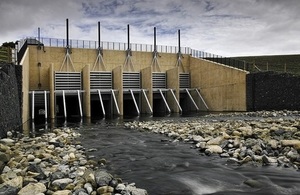Flood committee sets out £24million spending
Regional Flood and Coastal Committee sets out commitment to protect homes and businesses in the North East

Upstream dam and storage area at Morpeth
A flood and coastal group will oversee spending of more than £24million to protect hundreds of homes across the North East as it sets out its objectives for the next year.
The Northumbria Regional Flood and Coastal Committee (NRFCC) has launched its business plan for 2016/17, which will include work at Blyth, Killingworth, Hartlepool Headland Walls and Greatham South.
It also announced in its 2015/16 annual report that it’s overseen 125 projects costing £27million over the past year.
When all the work is complete it will have reduced the risk to 1,458 properties, while also making improvements to the environment.
Upcoming projects
Projects include the completion of the Port Clarence scheme at Wilton Engineering’s site in Teesside, the Morpeth flood alleviation scheme’s upstream dam and storage area – which operated for the first time in January - the Fellgate Estate scheme in South Tyneside, as well as the coastal scheme at Skinningrove.
The annual report and business plan together summarise the past year and look forward to the year ahead.
It is the second year of a six-year programme of works which was agreed in January 2015. The business plan will be updated each year to take into account any adjustments to the £108million, six-year programme.
Most projects in the plan are delivered by the Environment Agency and local authorities, with some carried out by, or in partnership with Northumbrian Water.
‘Great example of partnership working’
NRFCC Chairman Jon Hargeaves said:
On completion of the £27million programme of works from 2015/16, we will see a reduction in flood and coastal erosion risk to 1,458 houses in the region, as well as delivering seven environmental projects.
The committee is a great example of partnership working, with all local authorities, the Environment Agency and Northumbrian Water pulling together on behalf of residents and businesses in the North East.
It’s been a challenging year involving major flooding this past winter which affected hundreds of properties across the region. The committee is keen to understand the impact of this flooding and the issues relating to it.
At future meetings it will be discussed in further detail so we can make decisions moving forward into the years ahead.
Recovery projects underway
Currently, a £3million package of recovery projects to repair flood defences damaged in the winter flooding is taking place across the region, with a particular focus on the Tyne Valley in Northumberland.
Leila Huntington, Flood and Coastal Risk Manager with the Environment Agency in the North East, added:
We’re working hard to carry out permanent repairs to our damaged flood defences across the region.
We’re also continuing to investigate where new or improved defences can be incorporated into our works programme and will be discussing this process in detail with the committee.
The committee has an essential role in developing and delivering the flood and coastal risk management programmes. The work that has been carried out over the past year has brought significant benefits to communities, property, business and the environment.
Fellgate success
The £800,000 Environment Agency funded scheme on the Fellgate Estate in Jarrow, carried out by South Tyneside Council and Northumbrian Water, is one of the first in the country to see a local authority, water and sewerage company working together to tackle flood-affected properties.
South Tyneside Council’s Lead Member for Area Management and Community Safety, Councillor Moira Smith, said:
Thanks to a successful partnership, we were able to bring to fruition a scheme which not only reduces flood risk, but also offers wider benefits such as habitat creation, educational opportunities and enhanced health and wellbeing for residents.
By working sustainably and in partnership, the scheme also delivered cost savings of around 36% as well as overwhelming customer satisfaction.
The committee receives funding from a variety of sources, including from Government Grant-in-Aid, public and private contributions and a levy raised through local authorities.
The committee consists of elected and independent members and plays an important part in deciding local priorities for the flood and coastal risk management programme in North East England.
Anyone who would like a copy of the business plan or annual report should email nrfcc@environment-agency.gov.uk